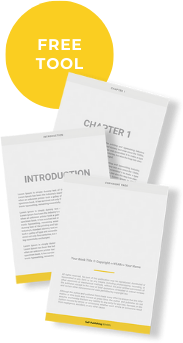If you’re embarking on the journey of writing a novel, you probably have several questions about where and how to start.
Planning and outlining your story in advance can be extremely helpful, but a big question that a lot of new authors have is “How many chapters should I have in my book?”


Book Outline Generator
Choose your Fiction or Nonfiction book type below to get your free chapter by chapter outline!
Book Outline Generator
Enter your details below and get your pre-formatted outline in your inbox and start writing today!
CONGRATULATIONS
Thanks for submitting! Check your email for your book outline template.
In the meantime, check out our Book Outline Challenge.

How many chapters should be in a novel?
The short answer is, unfortunately, that there is no one correct answer to that question. The average number of chapters in a novel, not accounting for genres or target audience is about a dozen.
However, there is no exact minimum or standard for how many chapters a novel should have. Because chapters are just places where the author decides to break up the flow of their story, you could go a more traditional route and end up with 12-28 chapters or choose to be more experimental and have as many as 200.
Looking at some popular novels, even with similar themes and audiences, there is a great variation in overall length and number of chapters.
The first installment in the Harry Potter series totaled 17 chapters with about 77,500 words total whereas The Hunger Games topped out at 27 chapters with a word count of 99,750.
Your story is unique, and the number and length of the chapters inside it will reflect that.
Here are the things you should keep in mind while trying to determine how many chapters YOUR novel should have:
Why Do We Use Chapters?
In trying to determine the number of chapters your novel will have you must first understand WHY you might want to include chapters at all. They aren’t mandatory by any means, but they can be a very useful tool in structuring the overall story in a way that is more easily digestible to the reader.
The end of each chapter gives the reader a solid place to take a moment and process everything they’ve just read. Since it’s not always feasible to read an entire novel in one sitting, they also allow for a practical place for the reader to take a longer break and do other things. But they shouldn’t be so satisfied that they don’t want to come back and read the next chapter.
With that in mind, it makes sense to break up your book into sections that leave the reader both with some level of fulfillment but with an eagerness to know more. No one chapter should wrap up the story entirely except the very last one. At the same time, you don’t want to keep raising questions that never get answered or issues that never get resolved. That’s a surefire way to disappoint or lose the attention of your reader.
Which Books Need Chapters?
Longer novels are likely to have more chapters simply because there will be more opportunities for breaks throughout the story. But what if you’re writing a shorter story? Shorter fiction can be a great way to experiment with flow and pacing and can help familiarize you with the process of writing and dividing a piece into chapters.
Short stories, which are usually between 1,000 and 7,500 words long and very rarely have chapters. They do, however, sometimes include scene transitions and breaks to denote a change in setting or scene, or the passage of time.
Novellas are longer than short stories, but still only clock in at around 20k words at their longest. With these, the line gets a little blurrier. You could choose to forego official chapters in favor of breaks as you would for a short story or break it into defined chapters. This decision will largely depend on the overall length of the novella and the number and lengths of scenes.
Even if you’re writing non-fiction, or another type of book, chapters can be a handy tool in your writer’s toolbelt. For example, a cookbook could even be divided into chapters that focus on a certain type of dish like dessert, or a certain type of cuisine like French.
When Should I Divide My Book Into Chapters?
Now you know why you need chapters, but when is a good time to divide your book into chapters? Should you decide during the outlining phase? Should you wait until the second draft?
There’s no “one size fits all” approach to writing a book. One person may strongly advise against writing without planning your chapters first, while others will tell you it’s illogical to even CONSIDER chapters at all until you have a solid first draft.
What works for you will depend largely on your personal writing style, but these are some methods to consider:
#1 – Write First, Ask Questions Later
One way to chop your book into chapters is to just write the whole thing as a draft and then go back through later and divide it into chapters where it makes the most sense. This will work better for those who consider themselves to be “pantsers”, or those who tend to write exploratory or “zero” drafts rather than abide by a specific outline.
With this method, you would write an entire first draft without worrying about specific chapter break placement. You can then read it back, making note of where breaks would make sense. This could be after major scenes Look for places where some questions have been resolved, but there is enough tension to keep the reader craving more. You don’t necessarily need to end each chapter with a classic cliffhanger, but you can use chapter breaks to highlight building tension and keep the reader on their toes.
Another way to determine where your chapter breaks should go is by looking for natural pauses in the story. Maybe you’ve reached the end of a major event or plot point. Perhaps your protagonist has just learned something that will change the course of their storyline. Anywhere that it would make sense for the reader to ruminate about what they just read is a great place for a chapter break.
#2 – Build Chapters Into Your Outline
If you are a staunch outliner and organizational savant, you might consider breaking your story into chapters before you even begin the first draft. This method will probably work best for people who like to have very specific and thorough outlines.
Using this method, you can plan which scenes you want to include in each chapter and have them work intentionally with the overall structure of your story. This should also make the process of writing and editing your first draft easier. You can always rework them if you find out that it’s not working properly as planned, but it will give you a great jumping off point.
#3 – By the Numbers
If you don’t want to do a thorough outline, but want a good way to gauge how many chapters you should end up with, you can use an average number for whichever genre and category you are writing as a good base and go from there.
For instance, an average YA novel is between 55,000 and 80,000 words long. Most experts agree that 3,000-5,000 words per chapter is a good guideline to follow. So, 12-27 chapters for a YA novel would be a good range to start with.
From there, you can narrow it down a little more by checking out similar books within the specific genre you’re writing. Contemporary stories in the YA category tend to be shorter, whereas fantasy and sci-fi are usually longer and more complex.
Shawn Coyne from Story Grid does a great job at explaining the math of a novel here, including a breakdown of key scenes, word counts, and act structure.
What Makes A Good Chapter?
The most important thing to consider when determining how many chapters your book will have is the content, pacing, and flow of your story. You want to ensure that each chapter starts in a place that engages the reader, keeps their interest throughout, and ends in a way that leaves them wanting to know more.
Generally, you should try to resolve at least one thing by the end of each chapter, in order to give the reader some sense of satisfaction but leave the door open for them to continue reading.
How Long Should Each Chapter Be?
Chapters usually range from about 1,500 to 5,000 words. The length of each chapter will vary throughout your novel depending on how it’s paced and how much information is in each section. What genre you are writing and who you’re writing for could play a part as well. Some genres leave more room for experimentation when it comes to chapter length, but it’s important to keep your reader in mind. One chapter from Stephen King’s 1987 novel Misery was comprised of a single word— “Rinse”.
Shorter chapters can greatly influence the pacing of a novel and help to build tension. Conversely, longer chapters may serve to slow a story and can be used to communicate more thoroughly. Both should be used cautiously and intentionally so that readers don’t feel like they are slogging through or being rushed through with little to no respite.
Should My Chapters Have Titles?
Titling chapters is yet another thing that mostly comes down to preference. Chapter titles aren’t usually necessary, but some authors like to include them.
Before you decide to give the chapters in your book titles, consider the following:
#1 – Will Chapter Titles Benefit the Story?
Chapter titles can be beneficial in multiple ways. They can serve as precursory hints of what is coming in each chapter. This could help spark the reader’s interest and spur them forward in the story.
They can also be very useful in differentiating characters in stories with multiple points of view. Each chapter can be titled with the name of the character through which the story is being told.
#2 – Will Chapter Titles Benefit the Reader?
Giving your chapters titles can be practically useful for your reader as well. If a reader wants or needs to refer to something that happened in an earlier chapter, it can be easier to find what they are looking for if each chapter has a unique title that is indicative of its contents.
They can also be used to give the reader more information or insight. In Annie Proulx’s novel The Shipping News, she uses the names and descriptions of different sailing knots like “Love Knot” or “A Rolling Hitch” which adds to the maritime feel of the story.
#3 – Can I Just Use Numbers?
If you’re not sure that titling your chapters is necessary, or you don’t think it would be beneficial to the reader or add to your story, you can always just use numbers.
It’s simple, classic, and a perfectly good way to label your chapter breaks without distracting from the story itself.
So How Many Chapters Should I Aim For?
As previously stated, there’s no magic number. The best way to know how many chapters you should write is to write an outline or draft and see what feels most natural with your story. Then make sure that it flows properly, and the pacing is on point.
Make sure that the position of the breaks adds to the story rather than detracting from it. When you have done all of that, you should end up with a perfectly appropriate number of chapters for your novel.
However, you may want to set a chapter goal as a way to visualize your book’s structure and motivate yourself. In that case, I recommend you shoot for 15 chapters in a first draft. If you write 15 chapters at an average of 4,000 words per chapter, you’ll have a solid 60,000-word manuscript. From there you can add to or edit down to get your desired length.


Book Outline Generator
Choose your Fiction or Nonfiction book type below to get your free chapter by chapter outline!
Book Outline Generator
Enter your details below and get your pre-formatted outline in your inbox and start writing today!
CONGRATULATIONS
Thanks for submitting! Check your email for your book outline template.
In the meantime, check out our Book Outline Challenge.

What is the shortest chapter you’ve read that had a big impact on the story in some way? Tell us in the comments below how it affected the overall story.